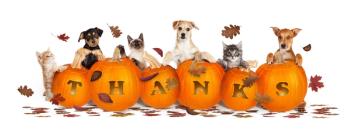
6 Tips for Keeping Your Pet Safe this Halloween
The American Society for the Prevention of Cruelty to Animals (ASPCA) has released its guidelines for keeping your pets safe this Halloween.
There’s no reason to let the humans have all the fun this Halloween. With an ever-expanding array of costumes for your four-legged friends, you might be thinking about getting your pets in on the Halloween excitement. Just make sure they skip the Halloween treats.
1. Be careful about putting your pet in a costume. Not all pets enjoy getting dressed up, the ASPCA cautions. So before heading out for your trick-or-treat journey, give your dog a chance to try on his or her costume first, and see how they react. “Some pets love the limelight, while others prefer to stick to their birthday suits for all occasions,” the ASPCA says. If your pet seems to be enjoying dressing up …
2. Make sure your pet is comfortable. Your pet should be able to move freely, hear clearly, and breathe with no restrictions. Keep an eye on your pet while out trick-or-treating, the ASPCA says. If it looks like they’re not having a good time, best to go back to the birthday suit.
3. If it can be chewed, it will be chewed. You’ll want to make sure that your pet’s costume doesn’t contain any choking hazards.
4. Halloween can be scary. With all of those people around, some of them in strange costumes, your pet might get startled and run away. Plan ahead and make sure your pet is wearing identifying tags. A reflective collar is also a smart option for safety, the ASPCA adds. And even if your dog is typically well-behaved off a leash, it might be wise to keep him or her tethered to you on this particularly frightening night. Furthermore, the ASPCA advises that if you have an anxious pet—even if you don’t plan on taking it out for Halloween—you might want to speak to your veterinarian about options to keep your four-legged friend calm. Droves of costumed children clamoring for candy have been known to make even humans anxious. Speaking of candy …
5. Keep an eye on the candy. If there’s candy in the house, your dog will nose it out, even if it’s carefully hidden, the ASPCA says. If your pet ingests any Halloween candy, contact your vet right away.
6. Beware of glow sticks. Cats get a kick out of batting them around, the ASPCA says, but dogs have also been known to break them. Their contents are typically non-toxic, however the ASPCA says pets have been known to ingest the bitter-tasting contents of glow sticks. If your dog or cat does, the ASPCA advises that you give them a treat or some milk to dull the taste. When in doubt, call your veterinarian.
Newsletter
From exam room tips to practice management insights, get trusted veterinary news delivered straight to your inbox—subscribe to dvm360.




